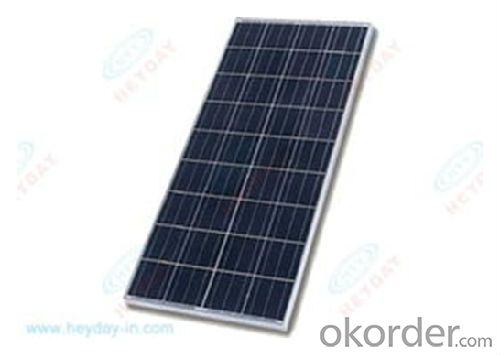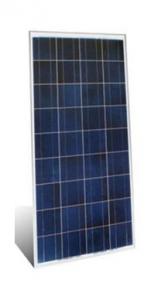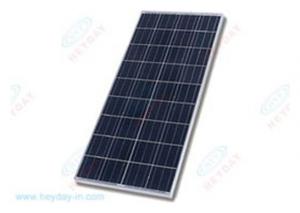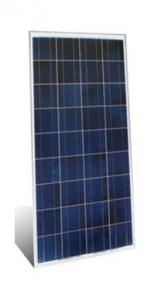Solar Modules Poly-crystalline 130W 156*156 Module
OKorder Service Pledge
OKorder Financial Service
You Might Also Like
Solar Module Descriptions:
Solar Power Modules (known as Photovoltaics - PV) can generate electricity for your home or business, either as part of a stand-alone solar power system, or for buildings already connected to the local electricity network.
Customers benefit from our progressive system innovations. Around the world, we meet our customers' desire for the greatest possible reliability, long-term performance and aesthetic integration. No matter which kind of roof – we always have the right solution.


Electrical Characteristics
Max-power (W) | 130 |
Max-Power Voltage (V) | 17.9 |
Max-Power Current (A) | 7.30 |
Open-Circuit Voltage (V) | 21.74 |
Short-Circuit Current (A) | 8.05 |
Mechanical Characteristics
Cable type, Diameter and Length | 4mm2, TUV certified, 1000mm |
Type of Connector | Compatible with MC4 plug |
Arrangement of cells | 4*9 |
Cell Size | 156*156 |
Dimension | 1482*676*40 |
Weight | 12Kg |
Glass, Type and Thickness | High Transmission, Low Iron, Tempered Glass 3.2mm |
Features
Guaranteed positive tolerance 0/+5w ensures power output reliability
Strong aluminum frames module can bear snow loads up to 5400Pa and wind loads up to 2400Pa.
Excellent performance under low light environments (mornings evenings and cloudy days)
12 years for product defects in materials and workmanship and 25 years for 80% of warranted minimum power.
Certifications and standards: IEC 61215.
Manufactured according to International Quality and Environment Management System (ISO9001, ISO14100).
FAQ
Q: Do you have any MOQ limit?
Our MOQ is 200 pieces.
Q: How long is the warranty period for the solar modules?
15 years 90% of its nominal power rating.
25 years 80% of its nominal power rating
- Q:Can a solar controller be used with solar-powered drones?
- Yes, a solar controller can be used with solar-powered drones. A solar controller is an essential component of a solar power system that manages the flow of electricity from the solar panels to the battery. In the case of solar-powered drones, the solar controller would regulate the charging of the drone's battery using the energy generated by the solar panels. This ensures that the battery is charged efficiently and prevents overcharging or damage to the battery. Furthermore, the solar controller can also provide important monitoring and protection functions, such as temperature compensation and over-discharge prevention, which are crucial for the safe and optimal operation of the drone. Overall, a solar controller is a valuable tool for integrating solar power into drone systems, enabling longer flight times and more sustainable operations.
- Q:Can a solar controller be used with high voltage solar panels?
- Yes, a solar controller can be used with high voltage solar panels. The purpose of a solar controller is to regulate and manage the charging process of solar panels, regardless of the voltage. It ensures that the batteries or other storage systems connected to the solar panels are charged safely and efficiently, regardless of the panel's voltage.
- Q:What is the difference between a solar controller and an inverter?
- A solar controller and an inverter are both essential components in a solar power system, but they serve different purposes. A solar controller, also known as a charge controller or regulator, is responsible for managing the power flow between the solar panels and the batteries. Its main function is to prevent overcharging or undercharging of the batteries by regulating the voltage and current from the solar panels. It ensures that the batteries receive the optimal amount of charge, extending their lifespan and maximizing their efficiency. Solar controllers are typically used in off-grid or hybrid solar systems. On the other hand, an inverter converts the direct current (DC) electricity produced by the solar panels or stored in the batteries into alternating current (AC) electricity, which is the type of electricity used in most household appliances and the power grid. Inverters are necessary in grid-tied solar systems because they allow the solar-generated electricity to be fed back into the electrical grid, reducing or eliminating the need for conventional electricity from the utility company. They also ensure that the AC power is synchronized with the grid's frequency and voltage requirements. In summary, while a solar controller regulates the charging of batteries and controls the power flow from solar panels to batteries, an inverter converts the DC electricity into AC electricity for use in homes or to be exported to the grid. Both components play crucial roles in a solar power system, ensuring optimal performance, efficiency, and compatibility with the electrical grid or off-grid setup.
- Q:What is the maximum voltage drop allowed between the solar panels and the solar controller?
- The maximum voltage drop allowed between the solar panels and the solar controller depends on the specific system and its components. Generally, it is recommended to keep the voltage drop below 2% for efficient operation. However, this value may vary depending on factors such as the distance between the panels and the controller, the size of the system, and the type of wiring used. It is important to consult the manufacturer's specifications and guidelines for the solar panels and controller being used to determine the maximum acceptable voltage drop.
- Q:What is the maximum temperature that a solar controller can withstand?
- The maximum temperature that a solar controller can withstand varies depending on the specific model and manufacturer. However, most solar controllers are designed to withstand temperatures up to around 60-70 degrees Celsius (140-158 degrees Fahrenheit).
- Q:What is the role of a solar controller in preventing battery over-voltage?
- The role of a solar controller in preventing battery over-voltage is to regulate the charging process of the battery when it is being charged by a solar panel. Solar panels generate electricity from the sun's energy, and this energy can vary depending on factors like sunlight intensity and temperature. A solar controller acts as a middleman between the solar panel and the battery, ensuring that the battery is charged safely and efficiently. One of its primary functions is to monitor the voltage level of the battery. If the voltage exceeds a certain threshold, which could potentially cause damage to the battery, the solar controller takes action to prevent over-voltage. To prevent battery over-voltage, the solar controller employs a technique called pulse width modulation (PWM) or maximum power point tracking (MPPT). These techniques help regulate the amount of current flowing from the solar panel to the battery, ensuring that the battery is charged at an optimal rate without exceeding its safe voltage limit. When the battery voltage approaches the maximum safe level, the solar controller reduces the charging current or temporarily interrupts the charging process. By controlling the charging rate, the solar controller prevents the battery from becoming overcharged, which could lead to issues like electrolyte loss, shortened battery lifespan, or even battery failure. Furthermore, solar controllers often provide additional protective features such as temperature compensation, which adjusts the charging voltage based on the battery's temperature. This ensures that the battery is charged optimally, considering the impact of temperature on its performance. In summary, the role of a solar controller in preventing battery over-voltage is to monitor the battery voltage and regulate the charging process to prevent overcharging. By doing so, it helps maintain the battery's longevity and ensures its safe and efficient operation in solar power systems.
- Q:Can a solar controller be used with solar panels of different manufacturers?
- Yes, a solar controller can be used with solar panels of different manufacturers as long as they have compatible specifications and voltage ratings. However, it is important to ensure that the controller is able to handle the combined power output of the panels and adjust its settings accordingly.
- Q:Can a solar controller be used with solar-powered telecommunications equipment?
- Yes, a solar controller can be used with solar-powered telecommunications equipment. A solar controller helps regulate the voltage and current from the solar panels to ensure the equipment receives a consistent and optimal power supply, which is essential for the reliable operation of solar-powered telecommunications equipment.
- Q:Can a solar controller be used with a solar-powered electric fence energizer?
- Yes, a solar controller can be used with a solar-powered electric fence energizer. The solar controller helps regulate and optimize the charging of batteries used in the electric fence energizer, ensuring efficient operation and extending battery life.
- Q:Can a solar controller be used in a solar-powered refrigeration system?
- Yes, a solar controller can be used in a solar-powered refrigeration system. A solar controller is used to regulate the flow of electricity from the solar panels to the system's batteries, allowing for efficient charging and preventing overcharging. In a solar-powered refrigeration system, the solar controller helps to ensure that the system operates optimally by managing the power supply and maintaining the required temperature levels.
1. Manufacturer Overview |
|
|---|---|
| Location | |
| Year Established | |
| Annual Output Value | |
| Main Markets | |
| Company Certifications | |
2. Manufacturer Certificates |
|
|---|---|
| a) Certification Name | |
| Range | |
| Reference | |
| Validity Period | |
3. Manufacturer Capability |
|
|---|---|
| a)Trade Capacity | |
| Nearest Port | |
| Export Percentage | |
| No.of Employees in Trade Department | |
| Language Spoken: | |
| b)Factory Information | |
| Factory Size: | |
| No. of Production Lines | |
| Contract Manufacturing | |
| Product Price Range | |
Send your message to us
Solar Modules Poly-crystalline 130W 156*156 Module
OKorder Service Pledge
OKorder Financial Service
Similar products
New products
Hot products
Related keywords





























